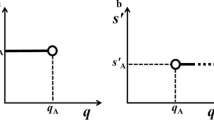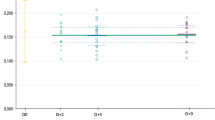Abstract
Immunochemical methods (in particular immunoassays) have been applied to spring and surface water samples, respectively, which were set-up as reference materials (RM) within two proficiency testing campaigns. For the first set of proficiency tests (PTs) described here (which were actually the second round of PTs organized, spring 2005), three ELISAs (enzyme-linked immunosorbent assays) were employed in the enzyme tracer format for isoproturon, diuron, and atrazine, respectively. Results were evaluated in comparison with conventional reference methods (LC, GC). Based on their Z-score laboratory performances, the results for isoproturon and diuron were satisfactory, both for fortified spring water and for the blind solution. The results for atrazine were strongly influenced by other triazines present and needed detailed interpretation. For the second set of PTs described here (which were actually the third round of PTs organized, spring 2006), two ELISAs in the coating antigen format were used for isoproturon and diuron, and the result was included with the results obtained by conventional methods during the PTs. The results (the Z-scores) for isoproturon were again classified as satisfactory, in both fortified surface water and blind solution. The results for diuron in ELISA showed an influence of the water matrix, while the analysis of the blind solution was satisfactory. In addition, an ELISA in the enzyme tracer format was applied to analyze isoproturon, diuron, and atrazine in surface water samples, which had been set-up and spiked during a field trial (tank experiment) at the Maas River at Eijsden, The Netherlands. The immunoassay results were compared with those from an in-house on-line SPE LC/MS–MS used as reference. Although the immunochemical results were sometimes higher than those determined in the reference analysis, the general concentration trends in the samples were similar. The contribution of immunochemical methods to the implementation of the European Water Framework Directive is also discussed.







Similar content being viewed by others
Abbreviations
- WFD:
-
Water Framework Directive
- CR:
-
cross-reactivity
- ELISA:
-
enzyme-linked immunosorbent assay
- ECD:
-
electron capture detector
- GC:
-
gas chromatography
- LC:
-
liquid chromatography
- MS:
-
mass spectrometry
- HRP:
-
horseradish peroxidase
- IC50 :
-
inhibitory concentration 50%, test midpoint of standard curve
- LOD:
-
limit of detection
- mAb:
-
monoclonal antibody
- PBS:
-
phosphate-buffered saline
- PBST:
-
phosphate-buffered saline with 0.05% (v/v) Tween 20
- PT:
-
proficiency test
- RM:
-
reference material
- TMB:
-
3,3′,5,5′-tetramethylbenzidine
References
EC (2000) Directive 2000/60/EC of the European Parliament and the Council establishing a framework for Community action in the field of water policy of 23 October 2000. Off J Eur Commun L 327:1–72
Krämer PM, Franke A, Zherdev AV, Yazynina EV, Dzantiev BB (2005) Talanta 65:324–330
Zhang X, Martens D, Krämer PM, Kettrup AA, Liang X (2006) J Chromatogr A 1102:84–90
Krämer PM, Goodrow MH, Kremmer E (2004) J Agric Food Chem 52:2462–2471
Krämer PM, Kremmer E, Forster S, Goodrow MH (2004) J Agric Food Chem 52:6394–6401
Karu AE, Goodrow MH, Schmidt DJ, Hammock BD, Bigelow MW (1994) J Agric Food Chem 42:301–309
Karu AE, Harrison RO, Schmidt DJ, Clarkson CE, Grassman J, Goodrow MH, Lucas A, van Emon JM, White RJ (1991) Monoclonal immunoassay of triazine herbicides: development and implementation. In: Vanderlaan M, Stanker LH, Watkins BE, Roberts DW (eds) Immunoassays for trace chemical analysis: Monitoring toxic chemicals in humans, food, and the environment. ACS Symp Ser 451:59–77
Martens D, Pantiru M, Forster S, Kettrup A (2004) Proc 2nd Asian Int Conf on Ecotoxicology and Environmental Safety, 26–29 Sept 2004, Songkla, Thailand
Krämer PM, Baumann, BA, Stoks, PG (1997) Anal Chim Acta 347:187–198
Bjarnason B, Bousios N, Eremin S, Johansson G (1997) Anal Chim Acta 347:111–120
Willard D, Proll G, Reder S, Gauglitz G (2003) Environ Sci Pollut Res 10 188–191
Rodriguez-Mozaz S, Reder S, de Alda ML, Gauglitz G, Barcelo D (2004) Biosens Bioelectron 19:633–640
Tschmelak J, Proll G, Gauglitz G (2004) Biosens Bioelectron 20:743–752
Tschmelak J, Proll G, Riedt J, Kaiser J, Kraemmer P, Bárzaga L, Wilkinson JS, Hua P, Hole JP, Nudd R, Jackson M, Abuknesha R, Barceló D, Rodriguez-Mozaz S, López de Alda MJ, Sacher F, Stien J, Slobodník J, Oswald P, Kozmenko H, Korenková E, Tóthová L, Krascsenits Z, Gauglitz G (2005) Biosens Bioelectron 20:1499–1508
Tschmelak J, Proll G, Riedt J, Kaiser J, Kraemmer P, Bárzaga L, Wilkinson JS, Hua P, Hole JP, Nudd R, Jackson M, Abuknesha R, Barceló D, Rodriguez-Mozaz S, López de Alda MJ, Sacher F, Stien J, Slobodník J, Oswald P, Kozmenko H, Korenková E, Tóthová L, Krascsenits Z, Gauglitz G (2005) Biosens Bioelectron 20:1509–1519
Acknowledgements
Dr. Nathalie Giugues, BRGM, Orléans, France, and Mr. Ian Allan, University of Portsmouth, Portsmouth, United Kingdom, are credited for the organization of the SWIFT field trial and for the provision of the water samples from the Maas River, Eijsden, The Netherlands, in April/May 2005. Dr. Marvin Goodrow (formerly UC Davis, CA, USA) is acknowledged for the synthesis of the haptens 1-(5-carboxypentyl)-3-(3,4-dichlorophenyl)-1-methylthiourea and 1-(3-carboxypropyl)-1-(3,4-dichlorophenyl)-3,3-dimethylurea (Diuron I). Dr. Herbert Muntau (Lithos Geosciences, Germany) is acknowledged for the organization of batch material sampling, Dr. Franz Ulberth, Dr. Marina Ricci and Dr. Ofelia Bercaru (IRMM, Belgium) for the preparation of RM08 and RM15, Dr. Angels Sahuquillo (University of Barcelona, Spain) for the preparation of RM17, Dr. Tristan Simonart (IPL, France) for the preparation and characterization of the pesticide pills, and Dr. Erwin Rosenberg and Dr. Eva Fernandez (Technical University of Vienna, Austria) for the characterization of the test materials. Major parts of this research were funded by the EU project SWIFT-WFD (SSPI-CT-2003-502492).
Author information
Authors and Affiliations
Corresponding author
Rights and permissions
About this article
Cite this article
Krämer, P.M., Martens, D., Forster, S. et al. How can immunochemical methods contribute to the implementation of the Water Framework Directive?. Anal Bioanal Chem 387, 1435–1448 (2007). https://doi.org/10.1007/s00216-006-0793-7
Received:
Revised:
Accepted:
Published:
Issue Date:
DOI: https://doi.org/10.1007/s00216-006-0793-7




